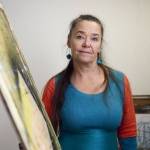Replaces one-year advanced programme in art therapy
At OsloMet, there is nearly 25 years of art therapy experience through further education in art therapy. This one year advanced programme in art therapy is now being replaced by the new master’s degree programme.
The art therapy programme option will be delivered as a part-time programme spanning three years and will be taught in English, but students will have the opportunity to complete their exams in a Scandinavian language.
The programme is research-based, and all the courses include practical training in art therapy methods.
“The art therapy programme has been designed for those with a deep interest in the therapeutic aspects of art processes and interaction with people, both in practice and in research,” Rankanen explains.
“Applicants should have an interest in studying and critically reflecting on their own and relational experiences and feelings associated with the art therapy process and its effects. Applicants should also be able to tolerate differences and accept incompleteness as part of the art therapeutic process of development and change.”

First in the Nordic region
Rankanen looks forward to welcoming the first-year group next autumn.
“I am delighted that we are finally able to launch the first master’s degree programme in art therapy and contribute towards the establishment and development of research-based art therapy practices not only in Norway but in the Nordic region as a whole.”
“I am also looking forward to the opportunity to develop interdisciplinary art therapy research projects at OsloMet.
The new study programme has been in the planning for quite some time and the journey has, at times, been tortuous. However, this was not all negative,” according to Rankanen.
“The lengthy process allowed us to develop the contents of the art therapy courses together with international and Norwegian art therapists, educators and researchers.”
“It also enabled us to participate in highly inspiring interdisciplinary development processes and discussions internally at OsloMet, as well as between the Faculty of Health Sciences and the Faculty of Technology, Art and Design.”
“In this way, we have succeeded in creating a well-functioning structure and fascinating content for the art therapy programme option.”








